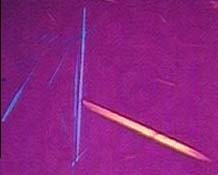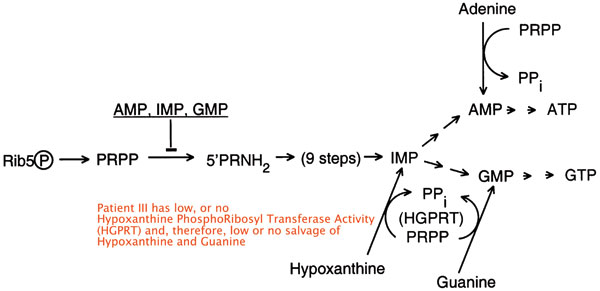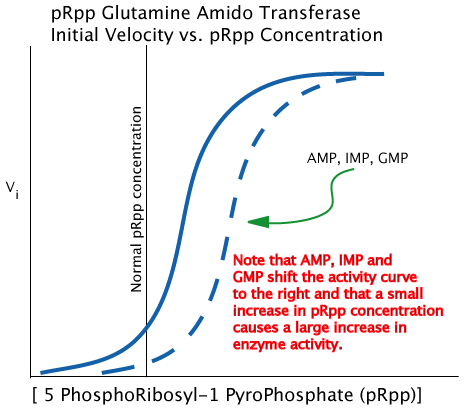Patient III:
The cells of Patient III undergo more de novo purine biosynthesis.
Partial or nearly total loss of Hypoxanthine Guanine PhosphoRibosyl Transferase (HGPRT) results in increased de novo purine biosynthesis for two reasons:
- Decreased levels of IMP and GMP, which are allosteric inhibitors of 5 PhosphyRibosyl-1 PyroPhosphate Glutamine Amidotransferase, the committed step of de novo purine biosynthesis. Decreased IMP and GMP levels result from the failure to salvage Hypoxanthine and Guanine to IMP and GMP due to decreased HGPRT activity in Patient III.
- Increased 5 PhosphyRibosyl-1 PyroPhosphate, which drives the committed step of de novopurine biosynthesis by the enzyme 5 PhosphyRibosyl-1 PyroPhosphate Glutamine Amidotransferease. The increased level of 5 PhosphyRibosyl-1 PyroPhosphate results from the failure to use it in the HGPRT purine salvage pathway due to decreased HGPRT activity in Patient III.
-
Due to the failure to salvage Hypoxanthine and Guanine, they are shuttled into uric acid synthesis.
- Due to increased de novo purine biosynthesis, Patient III synthesizes greater than normal amounts of purines. Ultimately, the increased purines are degraded to uric acid.
 Uric Acid in the body, particularly in males, is normally close to the
saturation level, and when excess uric acid is produced, as in HGPRT deficiency,
sodium urate crystals (figure shows "needle-like" crystals of sodium
urate) form in joints, most notably, in the joints of the big toes. A
partial loss of HGPRT is a form of gout, and nearly total loss results
in the Lesch-Nyhan Syndrome.
Uric Acid in the body, particularly in males, is normally close to the
saturation level, and when excess uric acid is produced, as in HGPRT deficiency,
sodium urate crystals (figure shows "needle-like" crystals of sodium
urate) form in joints, most notably, in the joints of the big toes. A
partial loss of HGPRT is a form of gout, and nearly total loss results
in the Lesch-Nyhan Syndrome.
Interestingly, in glucose-6-phosphatase deficiency, increased shunting of glucose through the pentose phosphate pathway also increases liver 5 PhosphyRibosyl-1 PyroPhosphate, which is synthesized from Ribose-5 Phosphate, a product or the pathway The increased levels of 5 PhosphyRibosyl-1 PyroPhosphate result in mild gout due to increased (excess) de novo purine biosynthesis.
 Allopurinol, a 7-8 isomer of hypoxanthine can be used to help releive
the gout.
Allopurinol, a 7-8 isomer of hypoxanthine can be used to help releive
the gout.
On your own, describe the logic for using allopurinal to releive gout
Lesch-Nyhan Syndrom (LNS) is an X-linked recessive disease present at birth in baby boys. The lack of HPRT causes a build-up of uric acid in all body fluids, and leads to symptoms such as severe gout, poor muscle control, and moderate retardation, which appear in the first year of life. A striking feature of LNS is self-mutilating behaviors characterized by lip and finger biting that begin in the second year of life. Abnormally high uric acid levels can cause sodium urate crystals to form in the joints, kidneys, central nervous system, and other tissues of the body, leading to gout-like swelling in the joints and severe kidney problems. Neurological symptoms include facial grimacing, involuntary writhing, and repetitive movements of the arms and legs similar to those seen in Huntington's disease. Because a lack of HPRT causes the body to poorly utilize vitamin B12, some boys may develop a rare disorder called megaloblastic anemia.
The prognosis for individuals with LNS is poor. Death is usually due to renal failure in the first or second decade of life.

